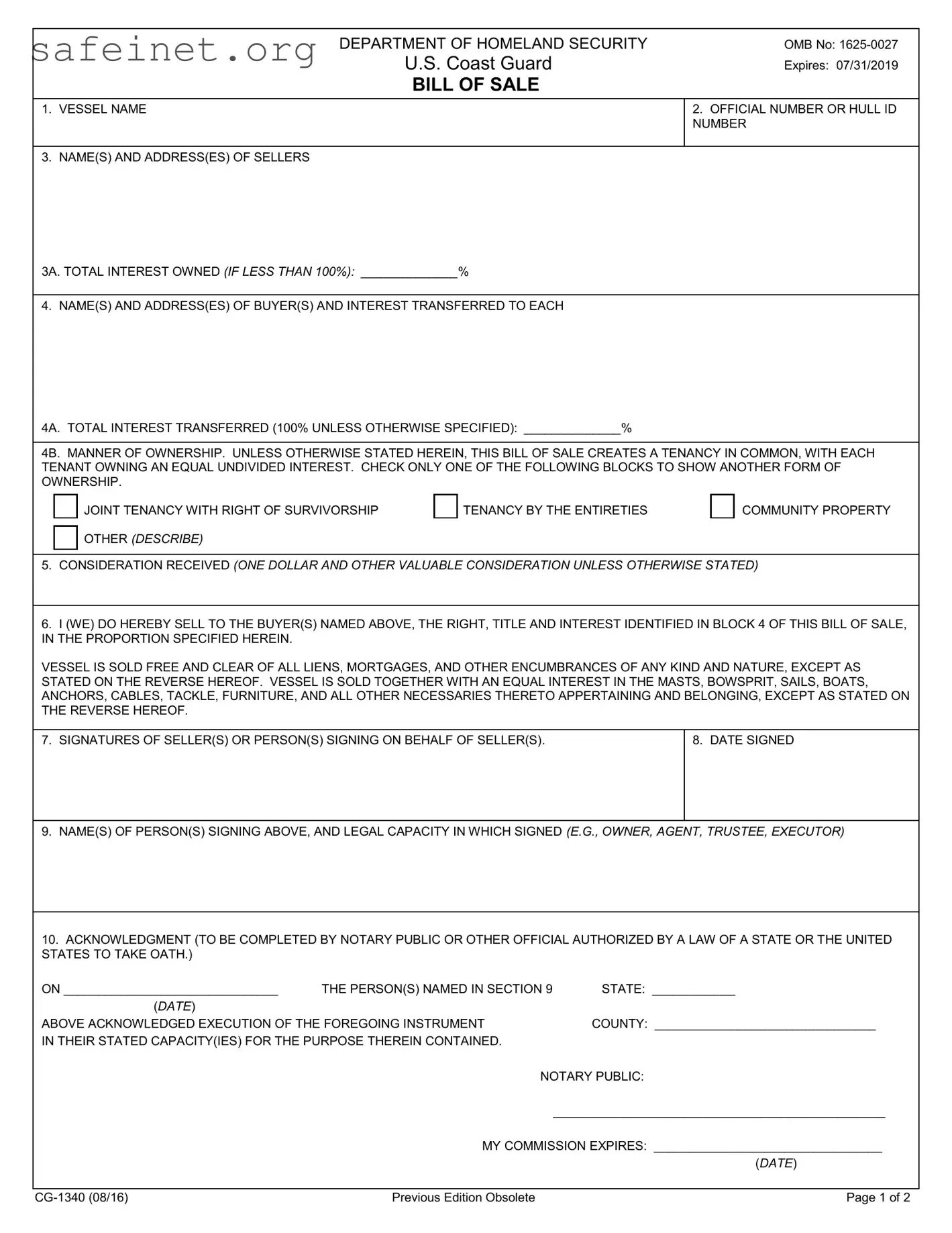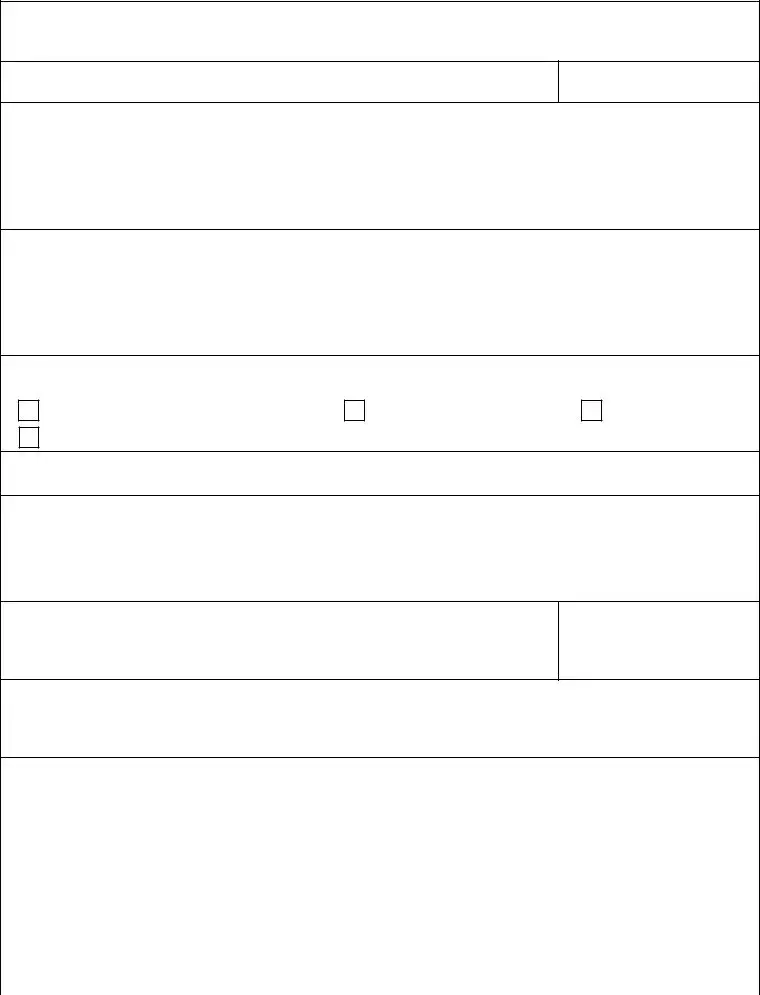DEPARTMENT OF HOMELAND SECURITY |
OMB No: 1625-0027 |
U.S. Coast Guard |
Expires: 07/31/2019 |
BILL OF SALE |
|
2.OFFICIAL NUMBER OR HULL ID NUMBER
3. NAME(S) AND ADDRESS(ES) OF SELLERS
3A. TOTAL INTEREST OWNED (IF LESS THAN 100%): ______________%
4. NAME(S) AND ADDRESS(ES) OF BUYER(S) AND INTEREST TRANSFERRED TO EACH
4A. TOTAL INTEREST TRANSFERRED (100% UNLESS OTHERWISE SPECIFIED): ______________%
4B. MANNER OF OWNERSHIP. UNLESS OTHERWISE STATED HEREIN, THIS BILL OF SALE CREATES A TENANCY IN COMMON, WITH EACH TENANT OWNING AN EQUAL UNDIVIDED INTEREST. CHECK ONLY ONE OF THE FOLLOWING BLOCKS TO SHOW ANOTHER FORM OF OWNERSHIP.
JOINT TENANCY WITH RIGHT OF SURVIVORSHIP
OTHER (DESCRIBE)
TENANCY BY THE ENTIRETIES
5.CONSIDERATION RECEIVED (ONE DOLLAR AND OTHER VALUABLE CONSIDERATION UNLESS OTHERWISE STATED)
6.I (WE) DO HEREBY SELL TO THE BUYER(S) NAMED ABOVE, THE RIGHT, TITLE AND INTEREST IDENTIFIED IN BLOCK 4 OF THIS BILL OF SALE, IN THE PROPORTION SPECIFIED HEREIN.
VESSEL IS SOLD FREE AND CLEAR OF ALL LIENS, MORTGAGES, AND OTHER ENCUMBRANCES OF ANY KIND AND NATURE, EXCEPT AS STATED ON THE REVERSE HEREOF. VESSEL IS SOLD TOGETHER WITH AN EQUAL INTEREST IN THE MASTS, BOWSPRIT, SAILS, BOATS, ANCHORS, CABLES, TACKLE, FURNITURE, AND ALL OTHER NECESSARIES THERETO APPERTAINING AND BELONGING, EXCEPT AS STATED ON THE REVERSE HEREOF.
7. SIGNATURES OF SELLER(S) OR PERSON(S) SIGNING ON BEHALF OF SELLER(S).
9.NAME(S) OF PERSON(S) SIGNING ABOVE, AND LEGAL CAPACITY IN WHICH SIGNED (E.G., OWNER, AGENT, TRUSTEE, EXECUTOR)
10.ACKNOWLEDGMENT (TO BE COMPLETED BY NOTARY PUBLIC OR OTHER OFFICIAL AUTHORIZED BY A LAW OF A STATE OR THE UNITED STATES TO TAKE OATH.)
ON _______________________________ |
THE PERSON(S) NAMED IN SECTION 9 |
STATE: ____________ |
(DATE) |
|
|
ABOVE ACKNOWLEDGED EXECUTION OF THE FOREGOING INSTRUMENT |
COUNTY: ________________________________ |
IN THEIR STATED CAPACITY(IES) FOR THE PURPOSE THEREIN CONTAINED. |
|
|
NOTARY PUBLIC: |
|
|
________________________________________________ |
|
MY COMMISSION EXPIRES: _________________________________ |
|
|
(DATE) |
|
|
|
CG-1340 (08/16) |
Previous Edition Obsolete |
Page 1 of 2 |
VESSEL DATA
(COMPLETE THIS SECTION ONLY IF VESSEL HAS NEVER BEEN DOCUMENTED AND DOES NOT HAVE A HULL IDENTIFICATION NUMBER.)
A. BUILDER |
B. BUILDER’S HULL NUMBER |
|
|
|
|
C. FORMER NAME(S) |
D. FORMER MOTORBOAT NUMBERS |
|
|
|
|
|
E. FORMER ALIEN REGISTRATIONS |
F. DIMENSIONS |
|
|
|
L= |
B= |
D= |
G. PERSON FROM WHICH SELLER OBTAINED VESSEL |
SIGNATURE OF SELLER |
|
|
|
|
|
|
WARRANTIES/APPURTENANCES/LIMITATIONS/EXCEPTIONS
INSTRUCTIONS
1.INDICATE CURRENT DOCUMENTED NAME. (IF VESSEL HAS NEVER BEEN DOCUMENTED SELLER MUST COMPLETE AND SIGN DATA SECTION ABOVE.)
2.INDICATE OFFICIAL NUMBER AWARDED TO VESSEL OR HULL IDENTIFICATION NUMBER ASSIGNED BY MANUFACTURER. (IF THE VESSEL HAS NO HULL IDENTIFICATION NUMBER AND HAS NEVER BEEN DOCUMENTED, SELLER MUST COMPLETE AND SIGN THE VESSEL DATA SECTION ABOVE.)
3.INSERT NAMES AND ADDRESSES OF ALL PERSONS SELLING VESSEL, ALONG WITH TOTAL INTEREST OWNED BY THOSE PERSONS. IF MORE ROOM IS NEEDED, AN ATTACHMENT MAY BE MADE SHOWING THE ADDRESSES OF THE SELLERS.
3A. SELF-EXPLANATORY.
4.INSERT NAMES AND ADDRESSES OF ALL BUYERS, ALONG WITH THE INTEREST TRANSFERRED TO EACH. IF THERE IS MORE THAN ONE BUYER AND NO DIVISION OF INTEREST IS SHOWN, THIS BILL OF SALE WILL RESULT IN EACH BUYER HOLDING AN EQUAL INTEREST. (IF MORE ROOM IS NEEDED, AN ATTACHMENT MAY BE MADE SHOWING THE ADDRESSES OF THE BUYERS.)
4A. SELF-EXPLANATORY.
4B. CHECK ONE OF THE BLOCKS TO CREATE A FORM OF OWNERSHIP OTHER THAN A TENANCY IN COMMON. IF “OTHER” IS CHECKED, THE FORM OF OWNERSHIP MUST BE DESCRIBED.
5.OPTIONAL IF THE AMOUNT PAID FOR THE VESSEL IS INSERTED, IT WILL BE NOTED ON THE VESSEL’S GENERAL INDEX.
6.SELF-EXPLANATORY. USE “REMARKS” SECTION ABOVE IF VESSEL IS NOT SOLD FREE AND CLEAR, OR TO LIST VESSEL APPURTENANCES WHICH ARE NOT SOLD WITH THE VESSEL.
7.SELF-EXPLANATORY.
8.SHOW THE DATE ON WHICH THE INSTRUMENT IS SIGNED.
9.IN ADDITION TO THE PRINTED OR TYPED NAME OF THE SIGNER, SHOW WHETHER THAT PERSON WAS ACTING AS AN OWNER, AS AN AGENT FOR AN OWNER, AS TRUSTEE, AS THE PERSONAL REPRESENTATIVE OR EXECUTOR OF AN ESTATE, OR OTHER CAPACITY WHICH ENTITLED THAT PERSON TO SIGN THE BILL OF SALE.
10.ANY ACKNOWLEDGMENT IN SUBSTANTIAL COMPLIANCE WITH THE LAW OF THE STATE WHERE TAKEN MAY BE ATTACHED TO THIS INSTRUMENT IN LIEU OF THE PREPRINTED ACKNOWLEDGMENT.
PRIVACY ACT STATEMENT
1.AUTHORITY: 46 U.S.C. CHAPTER 313, COMMERCIAL INSTRUMENTS AND MARITIME LIENS AND 46 CFR PART 67, DOCUMENTATION OF VESSELS.
2.PURPOSE: TO PUBLISH AND PROVIDE A PUBLIC RECORD (AVAILABLE FOR PUBLIC INSPECTION/COPYING) OF THE SALE OR CHANGE OF OWNERSHIP OF A VESSEL WHICH IS DOCUMENTED, WILL BE DOCUMENTED, OR HAS BEEN DOCUMENTED PURSUANT TO 46 U.S.C. CHAPTER 121.
3.ROUTINE USES: AUTHORIZED USCG PERSONNEL WILL USE THIS INFORMATION TO VALIDATE THE SALE AND TO DEVELOP STATISTICAL DATA RELATED TO DOCUMENTED VESSELS. ANY DISCLOSURES OF DATA WITHIN THIS RECORD WILL BE MADE IN ACCORDANCE DHS/USCG-013, MARINE INFORMATION FOR SAFETY AND LAW ENFORCEMENT (MISLE), 74 FEDERAL REGISTER (FR) 30305, JUNE 25, 2009.
4.CONSEQUENCES OF FAILURE TO PROVIDE INFORMATION: VOLUNTARY. HOWEVER, FAILURE TO PROVIDE THE REQUESTED INFORMATION COULD PREVENT THE BILL OF SALE FROM BEING FILED. FURTHERMORE, BILLS OF SALE WHICH ARE NOT FILED ARE DEEMED INVALID AGAINST ANY PERSON EXCEPT THE GRANTOR OR A PERSON HAVING ACTUAL KNOWLEDGE OF THE SALE.
AN AGENCY MAY NOT CONDUCT OR SPONSOR, AND A PERSON IS NOT REQUIRED TO RESPOND TO A COLLECTION OF INFORMATION UNLESS IT DISPLAYS A VALID OMB CONTROL NUMBER.
THE COAST GUARD ESTIMATES THAT THE AVERAGE BURDEN FOR THIS FORM IS 20 MINUTES. YOU MAY SUBMIT ANY COMMENTS CONCERNING THE ACCURACY OF THIS BURDEN ESTIMATE OR MAKE SUGGESTIONS FOR REDUCING THE BURDEN TO: U.S. COAST GUARD, NATIONAL VESSEL DOCUMENTATION CENTER, 792 T J JACKSON DRIVE, FALLING WATERS, WEST VIRGINIA 25419, OR OFFICE OF MANAGEMENT AND BUDGET, PAPERWORK REDUCTION PROJECT (1625-0027), WASHINGTON, DC 20503.
CG-1340 (08/16) |
Page 2 of 2 |


